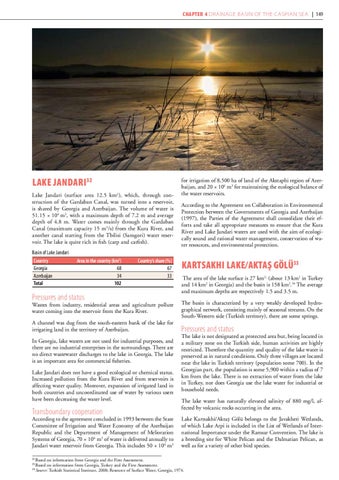Chapter 4 Drainage basin of the Caspian Sea | 149
Lake Jandari32 Lake Jandari (surface area 12.5 km2), which, through construction of the Gardaban Canal, was turned into a reservoir, is shared by Georgia and Azerbaijan. The volume of water is 51.15 × 106 m3, with a maximum depth of 7.2 m and average depth of 4.8 m. Water comes mainly through the Gardaban Canal (maximum capacity 15 m3/s) from the Kura River, and another canal starting from the Tbilisi (Samgori) water reservoir. The lake is quite rich in fish (carp and catfish). Basin of Lake Jandari Country Georgia Azerbaijan Total
Area in the country (km2) 68 34 102
Country’s share (%) 67 33
Pressures and status
for irrigation of 8,500 ha of land of the Akstaphi region of Azerbaijan, and 20 × 106 m3 for maintaining the ecological balance of the water reservoirs. According to the Agreement on Collaboration in Environmental Protection between the Governments of Georgia and Azerbaijan (1997), the Parties of the Agreement shall consolidate their efforts and take all appropriate measures to ensure that the Kura River and Lake Jandari waters are used with the aim of ecologically sound and rational water management, conservation of water resources, and environmental protection.
Kartsakhi Lake/Aktaş Gölü33 The area of the lake surface is 27 km2, (about 13 km2 in Turkey and 14 km2 in Georgia) and the basin is 158 km2.34 The average and maximum depths are respectively 1.5 and 3.5 m.
Wastes from industry, residential areas and agriculture pollute water coming into the reservoir from the Kura River.
The basin is characterized by a very weakly developed hydrographical network, consisting mainly of seasonal streams. On the South-Western side (Turkish territory), there are some springs.
A channel was dug from the south-eastern bank of the lake for irrigating land in the territory of Azerbaijan.
Pressures and status
In Georgia, lake waters are not used for industrial purposes, and there are no industrial enterprises in the surroundings. There are no direct wastewater discharges to the lake in Georgia. The lake is an important area for commercial fisheries. Lake Jandari does not have a good ecological or chemical status. Increased pollution from the Kura River and from reservoirs is affecting water quality. Moreover, expansion of irrigated land in both countries and uncoordinated use of water by various users have been decreasing the water level.
Transboundary cooperation
According to the agreement concluded in 1993 between the State Committee of Irrigation and Water Economy of the Azerbaijan Republic and the Department of Management of Melioration Systems of Georgia, 70 × 106 m3 of water is delivered annually to Jandari water reservoir from Georgia. This includes 50 × 106 m3
The lake is not designated as protected area but, being located in a military zone on the Turkish side, human activities are highly restricted. Therefore the quantity and quality of the lake water is preserved as in natural conditions. Only three villages are located near the lake in Turkish territory (population some 700). In the Georgian part, the population is some 5,900 within a radius of 7 km from the lake. There is no extraction of water from the lake in Turkey, nor does Georgia use the lake water for industrial or household needs. The lake water has naturally elevated salinity of 880 mg/l, affected by volcanic rocks occurring in the area. Lake Kartsakhi/Aktaş Gölü belongs to the Javakheti Wetlands, of which Lake Arpi is included in the List of Wetlands of International Importance under the Ramsar Convention. The lake is a breeding site for White Pelican and the Dalmatian Pelican, as well as for a variety of other bird species.
Based on information from Georgia and the First Assessment. Based on information from Georgia, Turkey and the First Assessment. 34 Source: Turkish Statistical Institute, 2008; Resource of Surface Water, Georgia, 1974. 32
33
